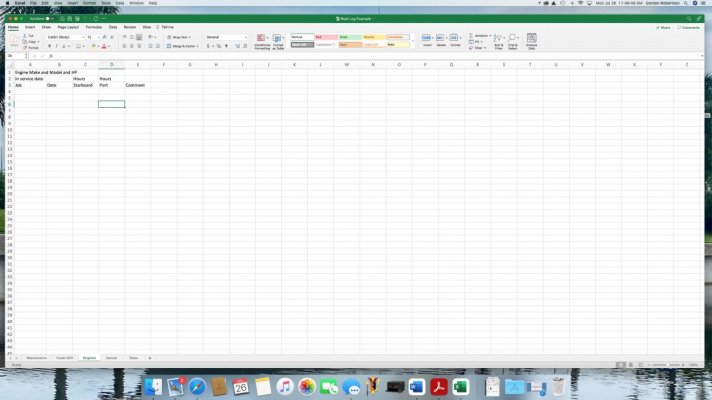I use Excel exclusively. The beauty of that is, you can do with it whatever you want. Your own custom log book software. If your OK in Excel, it does not take much to setup, and once it's setup, you can port it to new boats, show it to a prospective buyer (and give it to him/her at time of sale which will make they very happy...).
I keep about 15 different tabs in one big spreadsheet, which I print out whenever significant updates are made and put them in vinyl 3 ring sleeves which are inserted into a small 3 ring binder I keep on the boat for reference. I also keep an updated copy on my iPhone which I can reference anytime... you can also store it in the cloud if you wish, so you can always get to it from anywhere.
My main tabs are:
Reference Tab:
System(Hull, Mechanical, Electrical, Pluming, accessory), Make, Model, SN#, Date, Stock, Cost, Vendor, Notes
This is where I keep all parts of the vessel listed with where to get, cost, when I installed it/bought it, if I have any in stock if applicable(filters, zincs..). This tab starts small when you buy a boat, just the main stuff you know (hull, engines, transmissions, electronics....). Then as you learn more about the boat, or investigate things/replace/upgrade things you add to this tab. Add AC/heat, filters, zincs, cables, detailed items... Usually by the time I sell a boat, it's almost a complete parts list for the entire boat.
Ships Log Tab:
Date, Time, Engine Hours P & S, Distance, Place, Notes
Just a basic ships usage log,each time I use the boat it's logged in... even if I just idled in the slip for 20 minutes to warm up the motors to change the oil or something.
Fuel Log Tab:
Date, Engine Hours P & S, Gallons, Cost, Vendor, Notes, [MPG, GPH]
A basic fuel log, with some calculations in the last 2 columns to calculate MPG and gallons per hour based off the engine ours, and distances from the ships log and fuel log tabs. So you always have running totals, and can make sure nothing is changing. If fuel burn rates suddenly changes, you know it's telling you something... I also add a calculation based on average burn rates over time, to calculate how much fuel is left in the tank and the range left (estimates that after a few years, end up dead on!)
To Do List Tab:
A simple list of open items to do... no explanation required, we all have this list unfortunately!
 Maintenance Tab:
Maintenance Tab:
Item, Time-frame, Vendor, Notes, 2020, 2021, 2022, 2023, 2024....
A list of items that require regular maintenance, filters, zincs, oil changes, heat ex-changer clean-outs, windshield wipers,... You can get as detailed as you wish, I put in everything. If something is supposed to be changed every 3 years, I yellow highlight the box in that items row every 3 years so when I get to that year, I know it's due. I enter the date or engine hours into each items box under the year column when stuff is completed. A quick look at this tab, and you can see what was done, what wasn't, what's overdue, and whats upcoming next year at a glance.
Winterize Tab:
A simple todo list in order of what needs to be done to lay the boat up for winter, including a parts list of what's needed and whats in stock (antifreeze, oil, filters, zincs...).
Spring Commission Tab:
Same as above but for commissioning...
Electronic Interfaces Tab:
A reference list for what is connected to what, and using what wires and where. I include a picture of connection terminals where applicable. example: VHF yellow wire (NMEA+ in) to Garmin GPS blue wire (NMEA+ out)... This can be very helpful when somehting isn't working or you upgrading something....
Contacts/Vendors Tab:
.....
This entire thing comes in VERY handy when you are selling the boat as well!


 And looking forward to reviewing it.
And looking forward to reviewing it.